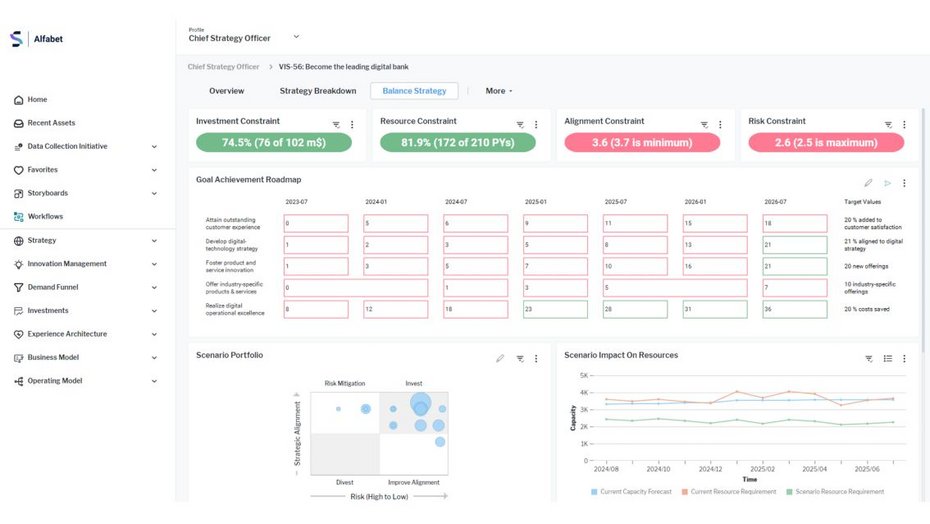Overview
The mission of the Strategy Realization Office (SRO) is to ensure that organizational investments align with the organization’s strategic goals. With today’s focus on accelerated business growth coupled with rapid technological change, business strategy can no longer be looked upon as a five-year plan. Even an annual strategy review does not allow an organization to adapt continuously as the business environment changes. The SRO must stay abreast of evolving business thinking and program delivery for optimized business outcomes—a complex but essential task.
Help is here: Leading international companies leverage strategic portfolio management (SPM) and enterprise architecture (EA) capabilities to continuously align business strategy with execution and delivery. Curious to know how?
The challenges in managing IT project portfolios
As stewards of the adaptive alignment of strategy and execution, staying informed about changes to strategy, outcome delivery, and enabling programs is crucial. Clear communication of your conclusions and proposals to business strategists and program managers ensures buy-in by all parties involved in the process. This requires a well-managed, integrated view of strategic portfolios, including business and IT roadmaps and outcome monitoring.
Do you have a clear visualization of how high-level vision translates into actionable strategic themes?
And, importantly, can you create and monitor the expected business outcomes? Using scenarios, you can optimize the cost, risks and benefits of strategy choices. Without that, you cannot adequately evaluate and communicate strategic choices.
Is the business you are serving understood?
Do business and program managers communicate strategic themes, value streams, goals, products and programs using common terms? Transparency in dependencies and communication of roadmaps and critical milestones is crucial to aligning execution with strategy.
Can you optimize investment portfolios to ensure maximum value delivery from programs and agile release trains?
Monitoring investments and adapting them to critical issues and strategic changes ensures agile alignment of strategy.
Do you have the tools to monitor, assess and align product and application portfolios with strategy, eliminating redundancy?
Modeling and predicting improvements in operative performance eliminates barriers and allows the enterprise to achieve its strategic goals.


Meeting these challenges with SPM and EA
Best-in-class Strategy Realization Offices integrate Strategic Portfolio Management (SPM) and Enterprise Architecture (EA) to bring necessary processes and governance into strategic alignment. In doing so, these core capabilities support different stakeholders by addressing critical questions:
- Is business strategy effectively communicated and monitored?
- Are strategy and investment dependencies well-understood?
- Are investments optimized for costs, risks, and business outcomes?
- Have stakeholders bought into the plan?
These key questions are answered by the following essential capabilities:
Business strategic planning
This capability gives you the tools to visualize business strategies and monitor outcome delivery. Strategic options are evaluated and communicated. Expose dependencies on value streams, business capabilities, programs, and products to support decision-making and roadmapping.
Business-IT relationship management
This capability takes the demands determined as a result of strategy development and operational necessity and provides a single point of capture and prioritization. It also supports trade-off discussions. Demand is linked to architecture for impact and synergy analysis, and to investments for implementation planning and monitoring. Innovation management brings new ideas and innovations into the process.
IT planning
In IT planning, business demand is converted into executable and funded programs. Target architectures and scenarios are developed and broken down into roll-out plans and project milestones. Roadmapping features support strategists and planners in developing roll-out strategies and iterating them with stakeholders to gain buy-in.
Enterprise architecture management
Enterprise architecture management supports the optimization of digital product and application portfolios to deliver an agile, fit-for-purpose landscape. Roadmaps give planners and strategists insights to understand the linkage between business outcomes and technology delivery allowing for synchronized delivery.
Role-based platform for roadmapping and communication
Alfabet’s role-based platform and workflow-supported processes help engage stakeholders and ensure alignment as a repeatable process. It provides many out-of-the-box stakeholder-oriented insights, dashboards and roadmaps. These are generated from SPM data, reducing manual effort and errors.
Leader in SPM and EA
Internationally renowned companies across the globe use the market-leading solution for SPM and EA—Alfabet. The platform provides a set of core capabilities to sustainably manage and ensure IT’s contribution to business value. SPM and EA aim to plan and monitor the performance of IT support throughout its entire life cycle—ensuring that business strategy and demands are fully understood, prioritized and executed, and that the costs, quality and risks to IT support are known and considered during decision making.
We establish more strategic goals in our organization because we’re now less risk averse about projects. Alfabet continuously tells us if our IT landscape is compliant with our goals. We get more compliant, we mitigate risk, and we become comfortable taking on more projects, both those for strategic initiatives and cost reduction.
About Alfabet
Alfabet is a leading enterprise platform with standard modules that support effective Strategic Portfolio Management (SPM) and EA, offering:
- The richest set of artifacts in the industry
- A single, central repository
- Role-based access and support for global communities
- Decision-ready reporting and publication
- Advanced support for the agile enterprise
- Broad and easy-to-use configuration
- Use of leading-edge AI technologies
- Support for federated enterprises


